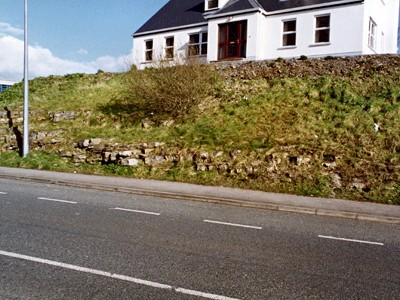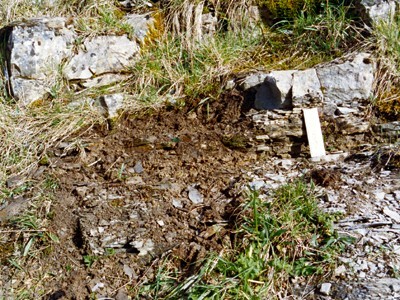Earth Science Conservation Review
| Lisnaskea road cutting | Fermanagh |
| Site Type: | Roadside section |
| Site Status: | ESCR |
| Council area: | Fermanagh District Council |
| Grid Reference: | H36213375 |
| Google maps: | 54.25136,-7.44461 |
| Rocks | |
|---|---|
| Rock Age: | Carboniferous (Visean) |
| Rock Name: | Benbulben Shale Formation, Dartry Limestone Formation |
| Rock Type: | Limestone, Mudstone |
| Interest | |
| Fossil Groups: | Foraminifera |
| Other interest: | Marine sediments |
Summary of site:
A total thickness of 7 m of rocks can be seen, tilted slightly to the east. Both formations belong to the Visean epoch of the early Carboniferous period.
The lowest 2.5 m of the section, the Benbulben Shale, consist of dark grey to brown mudstones with two thin magnesium enriched limestones containing sponge spicules near the base. The top of the formation is marked by a 10 cm bed of hard mudstone, much disturbed by the burrowing activities of invertebrates that lived in the mud of the sea floor. The limestone contains a small fauna of about 8 genera of microscopic foraminifera and a fragment of two-layered calcareous seaweed.
The upper 5.5 m of the section are the limestones of the Dartry Limestone Formation consisting of lime grains with some lime mud between them and splintery lime-rich mudstones. The limestone beds vary from thin to thick with wavy bedding planes and contain some chert nodules (masses of grained silicon dioxide) and one thin chert bed. The beds have been disturbed by burrowing. The mudstones contain sponge spicules, fish debris (scales, spines and teeth) and conodonts, the microscopic mouthparts of an extinct group of burrowers. There is also a small fauna, about eight genera, of foraminifera and it shares five of them with the Benbulben Shale.
The fossils give an age in the Asbian stage of the Visean, somewhere around 335 million years ago. At the time of the transition between the two formations the marginal coastal basin saw a rapid decline in the silts and muds that characterise the Benbulben Shale which gave way to sliding sheets of thick lime sands into deep water. The absence of large fossils suggests a hostile, deep and dark sea bed.
At the time, this basin was on the margin of the continent of Laurentia that straddled the equator on its imperceptible drift into the northern hemisphere.
Good exposures of the junctions between major formations are the exception, which makes this locality, with its ready access, of particular interest.
The lowest 2.5 m of the section, the Benbulben Shale, consist of dark grey to brown mudstones with two thin magnesium enriched limestones containing sponge spicules near the base. The top of the formation is marked by a 10 cm bed of hard mudstone, much disturbed by the burrowing activities of invertebrates that lived in the mud of the sea floor. The limestone contains a small fauna of about 8 genera of microscopic foraminifera and a fragment of two-layered calcareous seaweed.
The upper 5.5 m of the section are the limestones of the Dartry Limestone Formation consisting of lime grains with some lime mud between them and splintery lime-rich mudstones. The limestone beds vary from thin to thick with wavy bedding planes and contain some chert nodules (masses of grained silicon dioxide) and one thin chert bed. The beds have been disturbed by burrowing. The mudstones contain sponge spicules, fish debris (scales, spines and teeth) and conodonts, the microscopic mouthparts of an extinct group of burrowers. There is also a small fauna, about eight genera, of foraminifera and it shares five of them with the Benbulben Shale.
The fossils give an age in the Asbian stage of the Visean, somewhere around 335 million years ago. At the time of the transition between the two formations the marginal coastal basin saw a rapid decline in the silts and muds that characterise the Benbulben Shale which gave way to sliding sheets of thick lime sands into deep water. The absence of large fossils suggests a hostile, deep and dark sea bed.
At the time, this basin was on the margin of the continent of Laurentia that straddled the equator on its imperceptible drift into the northern hemisphere.
Good exposures of the junctions between major formations are the exception, which makes this locality, with its ready access, of particular interest.
| Enlander, I., Dempster, M. & Doughty, P., 2025. Lisnaskea road cutting, County Fermanagh, site summary. [In] Earth Science Conservation Review. https://www.habitas.org.uk/escr/summary.php?item=206. Accessed on 2025-04-03 |
| Previous Site | Next Site |

